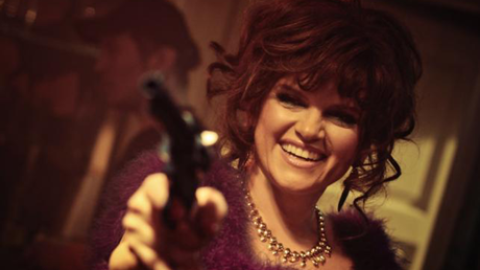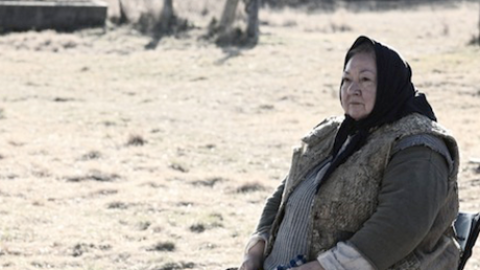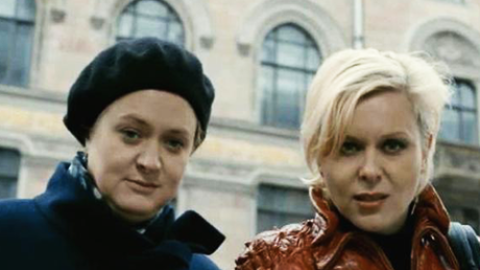Festivals: Karlovy Vary
“It went from ‘Workers of the world, unite!’ to ‘Workers of the world, kiss my ass!’”
—Eva Zaoralová
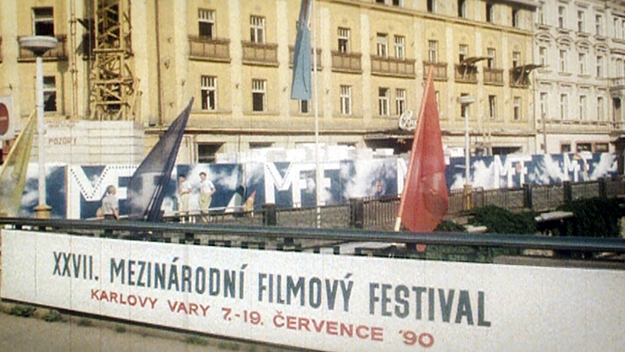
Film Spa
It’s with this sardonic epitaph in the documentary Film Spa that a former artistic director of the Karlovy Vary International Film Festival (from 1994 to 2010) jokingly describes the epochal shifts since its beginnings. Produced to celebrate the festival’s 50th anniversary, Miroslav Janek’s inevitably hagiographic film gives an agreeable account of its history complete with footage of famous guests and soothing sights. KVIFF, or Karlovy Vary as it’s usually called, was founded in 1946 as a non-competitive exhibition of films in Marienbad with joint screenings held in its current location, a high-end thermal resort, where the festival was permanently moved when the Communists came to power two years later, quickly becoming one of the regime’s cultural mouthpieces. In 1956, the International Federation of Film Producers Associations upgraded Karlovy Vary to a “category A” festival, and after 1959, with the launch of the Moscow film festival and the consequent decision to hold only one “category A” festival a year within the Eastern Bloc, it was held in alternate years until 1993.
The years leading up to the Soviet “normalization” of Czechoslovakia in 1968 saw the festival becoming a veritable “Cannes de l’est,” with international stars flocking to the well-appointed spa town. From Frank Capra to Claudia Cardinale, Emmanuelle Riva to Henry Fonda, the festival opened its doors to glamour while pursuing its stated goal of “peace among nations” and the “new man.” Karlovy Vary also stood out for innovations including an early incarnation of video-blogging, in the daily series of ironic recorded “moments” hosted by Miroslav Hornicek that staged amusing vignettes of festival life. It was the first festival to publish a daily, edited in multiple languages and packaged in the sublime graphic design of the time. Filing for FILM COMMENT in 1962, Edith Laurie enthusiastically celebrated the communal spirit of the festival, observing how “this intimacy among the festival visitors produces the kind of inbreeding unknown at a big-city festival like Berlin, at a chichi-resort festival like Cannes, or at a tourist-center festival like Venice.” Laurie went on to praise the fact that in Karlovy Vary “the differences between Big and Little countries are minimal,” and that upon leaving the festival, “you have to be deaf in both ears NOT to know about film production in Bulgaria and Algeria and the Congo.”
As Russian tanks entered Prague in the spring of 1968, clouds gathered in the sky over Karlovy Vary which, if you believe the archive footage in Film Spa, wouldn’t see a single ray of sun until 1990. With democracy, the sun returned, as the flags of non-aligned nations were swiftly replaced by advertising. Somewhat paradoxically though, the best films seen in Karlovy Vary this year all hailed from the dark Communist past, be they Czechoslovakian oldies or Soviet ones as in the case of Larisa Shepitko, to whom the festival dedicated a retrospective. In compliance with the resurgent wave of russophobia in Europe, especially deep-seated in the Czech Republic, the KVIFF website described Shepitko as a director of Ukrainian-Iranian origins (which is a little like calling Obama a politician of Hawaiian-Kenyan origins…). Though admittedly at odds with the ideological ossification that characterized the Soviet Union by then, her work proves that artistic nuance existed even within what is often depicted as a monolithic, wholly illiberal reality.
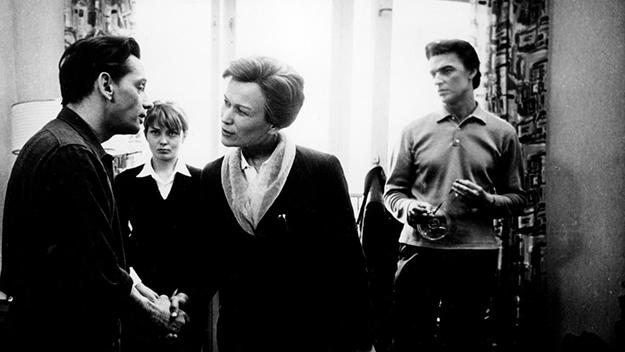
Wings
Shepitko’s four features are transcendental meditations on the fracture between the enforced dream of a collectivized being and the fragile finitude of the individual beset by existential qualms. Whether dealing with the disappointment of a war hero oppressed by the meaningless glory bestowed upon her in Wings (66) or the regrets of a doctor who chose conveniences over challenges in You and I (71), the director’s work portrays the absence of a common ground on which the public and the private could dialectically converse. Her schismatic poetic stance coalesces with near perfection in The Ascent (77), which was apparently loathed by Soviet censors but won the Golden Bear at the Berlinale. The film, the last Shepitko would complete before dying in a car accident, is set during the Second World War in the extreme subzero freeze of the Belorussian winter. Two partisans are caught by the Germans and their collaborators; sentenced to death along with two other culpable innocents, they have to face the verdict of their own conscience. An epic of war and resistance purged of the testosterone-powered clichés that come with the genre, The Ascent sublimates the heroic Soviet opposition against the Nazis into a celestial parable of spiritual minimalism. Strength and determination emanate from the very moral core of the protagonist, a Christ-like figure who doesn’t fit the usual mold of the war hero.
Historically open to films from across the globe, the focus of Karlovy Vary has always been Eastern and Southeastern Europe, though the most notable films from those regions have typically been “discovered” or co-opted by other festivals first. Such was the case with the Czech New Wave in the Sixties as it was more recently with the films coming from Romania for instance. In its recent incarnations, the festival seems to have functioned more as a showcase than a launching pad for new talents, or, as a veteran Czech film critic sarcastically puts it in Film Spa, the place where people who didn’t get invited to other, more prestigious festivals end up. But bringing new and old films to local audiences and professionals alike remains a very honorable mission and, judging from the very young age of the average festivalgoer in Karlovy Vary, one that still makes a lot of sense. KVIFF is a very much felt and celebrated affair in the region, and if it’s not on the hot list of “cool” festivals, that’s not for lack of trying or due to some innate provincialism.
Still, if major film festivals fail to fill their lineups with films that demand to be seen, it’s not difficult to imagine how daunting the programmers’ task can be in a festival like Karlovy Vary, something the official competition incontrovertibly showed. Though films of a certain peripheral interest were present, as far as your correspondent is concerned there were no exceptional titles that long-term memory will preserve. Winner of the Crystal Globe, the festival’s highest award, Bob and the Trees by French-born Diego Ongaro features a charismatic performance by its main protagonist, but the script wears thin as the film unfolds. Bob is an American logger, the old-fashioned kind, not too keen on branding his business but able to sense the way in which the natural environment around him is changing. A series of ambiguous misfortunes hit plucky Bob, his land, and his cow. Caught between slightly paranoid suspicions and a monomaniacal determination to solve it all by himself, Bob drives off to the strains of “Point of No Return” by Immortal Technique, into an unknown future. Bob Tarasuk, playing himself, delivers an engaging performance but he’s failed by a narrative shell that ill fits its leading character.
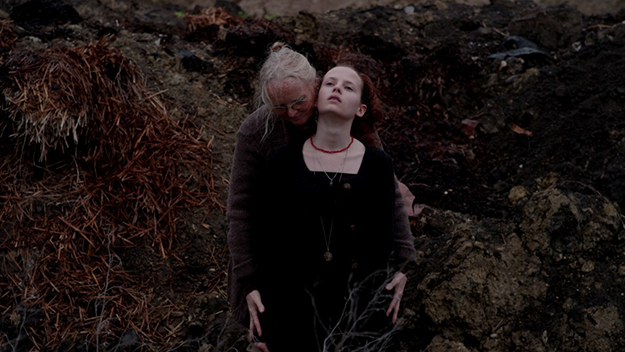
Those Who Fall Have Wings
Very much like its protagonist, Bob and the Trees is an earthbound film pretending not to be something other than itself. The same does not apply to the Special Jury Prize winner Those Who Fall Have Wings by Austrian filmmaker Peter Brunner. Able to create images of sinister cogency, the director sets himself a rather challenging task: to explore the ways in which one comes to terms with death. The film follows two sisters, Kati and Pia, who spend their days at their grandma’s isolated country house besieged by a sinister sense of claustrophobia. Despite their grandmother’s ostensibly reassuring words, the menace doesn’t fade away. Death is the invisible and unspoken protagonist of a film that can’t stand up to the poetic challenge it sets itself. The very subject is not the easiest of endeavors for any director, and it’s unclear whether the overall indeterminacy and confusion of the film is intentional or stems from an inability to handle such complex subject matter. Inadequate expression coupled with disproportionate ambition was a recurring feature in the films in competition. It was to be found in The Red Spider, a beautifully shot reconstruction of Poland’s most infamous serial killer that was devoid of any penetrating quality beyond its polished surface. Likewise, in Song of Songs, the beautiful cinematography lays out in faithful detail a Jewish shtetl at the beginning of the 20th century but can’t conceal the film’s discomfiting narrative void. It’s still a significant film, considering its country of origin, Ukraine, where the new, Western-backed government has been naming streets after Nazi collaborators.
Rather than individual “failures,” what these films represent is the general incapacity in contemporary European cinema to give a coherent shape to the complexity of feelings, intuitions, and impressions we experience and the wider context from which they originate. As if the chaotic world in which we live, love, struggle and suffer, watch and make films, required a new language we still haven’t mastered, or can’t even comprehend yet.



